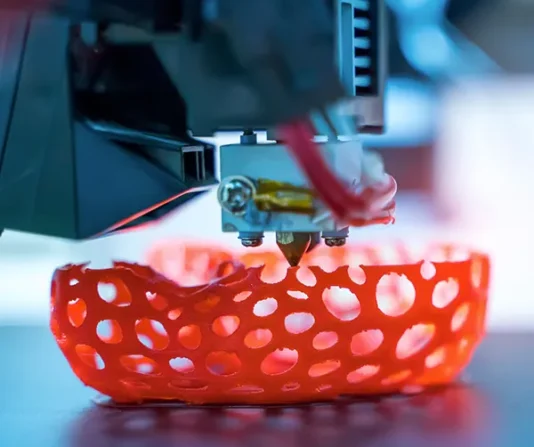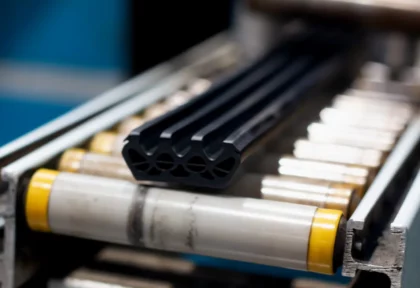Plastic materials for 3D printing
In 3D printing, plastics offer a versatile solution and are particularly well-suited for small series and prototyping projects. Protolis provides an assortment of plastic grades, each tailored to offer distinct advantages.
- Availability: Plastic 3D printing materials come in various types, allowing for a wide variety of applications. Gain access to the right material for your specific 3D printing needs
- Customization: Choose from a diverse range of finishes for both aesthetic and functional possibilities
Common 3D plastics
Discover the possibilities of plastic materials for 3D printing.
Description
This grade is a high-performance semi-crystalline thermoplastic. It has excellent mechanical properties in terms of toughness and high strength, good resistant to heat, high temperature, abrasion, and wear. The chemical resistance is good with high dielectric strength.
Applications
Alternative to aluminum and steel in certain cases
Commonly used in transport and aeronautics
Description
This plastic has excellent mechanical properties, including high fatigue resistance and excellent chemical resistance. It a lighter alternative to aluminum and steel in certain use cases.
Applications
Alternative to aluminum and steel in certain cases
Commonly used in transport and aeronautics
Description
This is a general-purpose grade that offers excellent strength, thermal stability, and the ability to withstand steam autoclaving. It has the highest heat resistance with UL94 V0 certification.
Applications
Food production tools
Custom medical appliances
Aerospace and automotive parts
Description
This is a high-performance thermoplastic with superior mechanical properties, including a high strength-to-weight ratio. It has good FST (flame, smoke, and toxicity) resistance and good chemical resistance. It is a flame-retardant UL94V0.
Applications
Digital manufacturing
Rapid prototyping
Transportation
Aerospace
Description
This is an SLA transparent resin with similar properties to UTR 9000. It commonly used for parts with higher surface finishing requirements.
Applications
Master patterns
Concept models
General parts
Functional prototypes
Description
This grade is a synthetic thermoplastic polymer with the lowest melting point of all nylon. It has high strength, high elongation and flexibility, good chemical resistance, low friction, and good dimensional stability. It is also suitable for painting, impregnating, coating, and sandblasting.
Applications
Possible substitute for injection molding plastics (medical applications, automotive design, production parts).
Description
This resin is highly accurate and durable material. Commonly used for stereolithography, it has a medium viscosity, good strength and flexibility, and strong resistance to yellowing.
Applications
Master patterns
Concept models
General parts
Functional prototypes
3D plastic printing services
3D printing, or additive manufacturing, creates precise complex plastic parts—including hollow and undercut components—using layer-by-layer material addition from digital models that surpasses traditional machining in speed and precision.
At Protolis, we offer plastic 3D printing services for low-volume manufacturing and rapid prototyping. That includes high-quality 3D production processes such as stereolithography (SLA), selective laser sintering (SLS), and fused deposition modeling (FDM).
3D plastic printing services

Our finishes for plastics 3D printing
Our selection of 3D printed plastics comes with a variety of finishing options, such as painting, technical or cosmetic polishing, and chrome plating.

The pigmentation process makes it possible to produce pieces naturally colored in the mass of certain plastics. It is possible to choose the desired RAL or Pantone, with color pigments mixed with the material. This is applicable for rigid or flexible parts.

A paint finish that enhances the surface condition both functionally and aesthetically. It is possible to achieve different effects of appearance: satin, matte, gloss, or semi-gloss.

There are several degrees of transparency depending on the technologies and materials used. The opacity can also be manually adjusted by polishing, sanding, or pigmentation.
To learn more about these finishing options, please refer to our finishes page.
Our 3D printing plastics characteristics
FDM & SLS: DIN 7168-91, class m
FDM & SLS: DIN 7168-91, class m
Your project in 5 steps
When you work with Protolis, you can expect personalized service, clear communication, and rapid turnaround of your 3D plastic prototypes and production parts. Here’s how it works.
Your quote
Upload files and specifications
DFM
Design optimization
Production
Close follow-up
Quality control
Dimensional report, pictures, and videos
Delivery
Packing, door-to-door tracking
3D printing plastics FAQs
Why use 3D Printing for your prototyping project?
The main advantages of 3D printing include speed, design freedom, and minimal technological and preparatory constraints. It is cost-effective for low volumes, providing design flexibility, a variety of materials, and few design constraints.
What plastic can be used for 3D Printing?
The range of plastics used in 3D printing is constantly evolving. Today, there are many plastic options with different properties, available in various forms such as filament or powder, depending on the technology used. The main plastics available include ABS, PLA, PETG, nylon, TPU, TVA, and HEPS, as well as several types of possible resins in SLA.
Is PLA good for prototyping?
Yes, PLA is a very popular choice. It’s inexpensive, easy to print, cost-effective, and has good dimensional stability, along with a pleasing aesthetic and finish. It’s also biodegradable. However, it comes with limitations in terms of mechanical and thermal properties, and it tends to yellow over time. Its lifespan is not very long.
Related resources

Extrusion Guide

Racing car bodywork for one of the world’s premier auto shows















